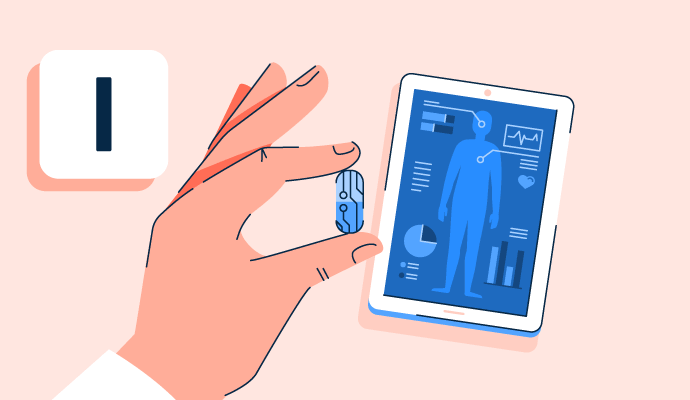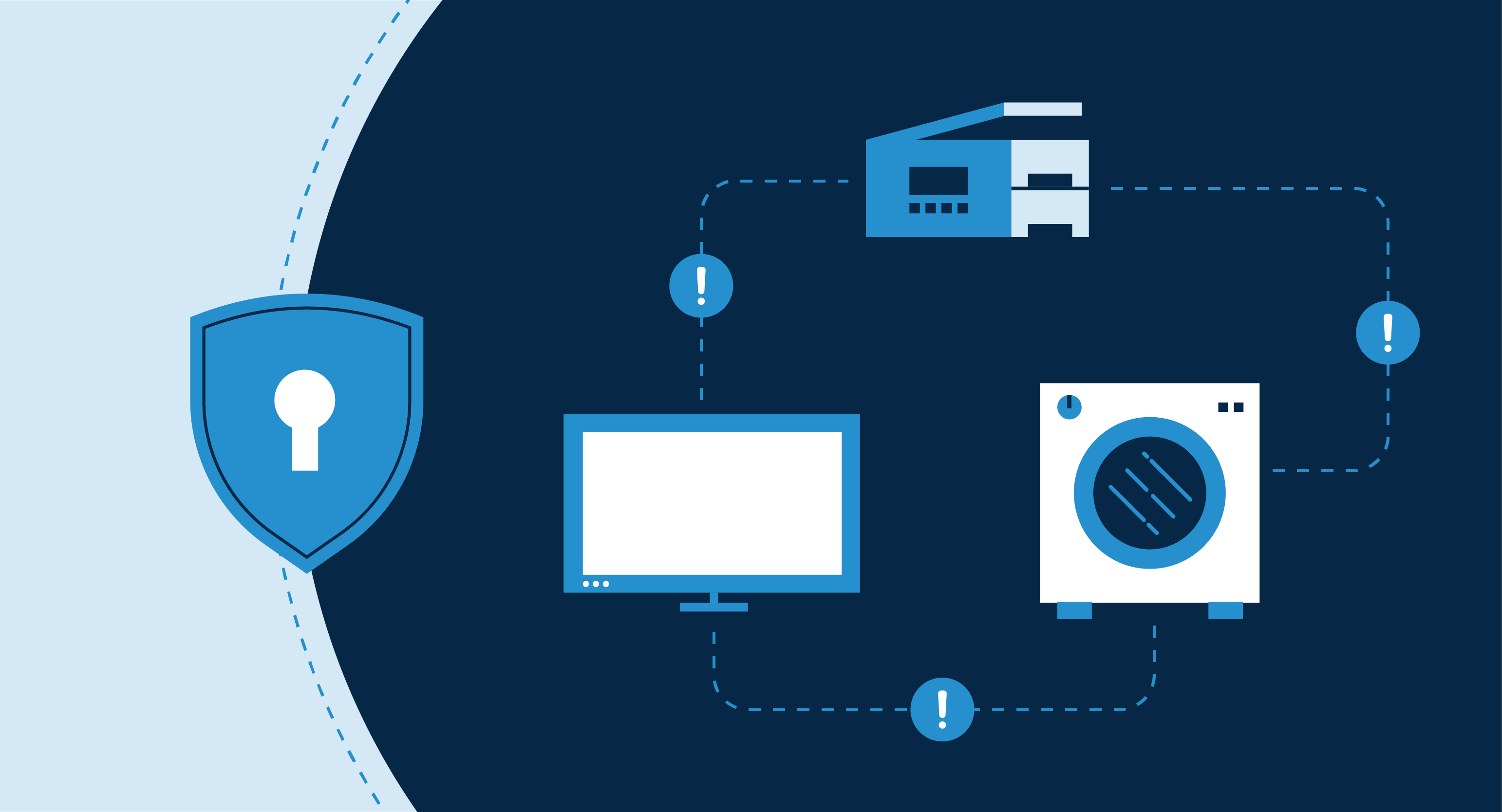What is the Internet of Things (IoT)?
The Internet of Things (IoT) allows communication between interconnected devices. Billions of physical devices are connected to the internet that communicate and collect real-time data without human involvement.
IoT is everywhere, from smartphones to smart TVs and refrigerators to smart pills that help doctors monitor patients and suggest diagnoses.
IoT makes ordinary objects intelligent and interactive by connecting them to other objects and cloud applications. Many organizations use IoT platforms to properly handle their IoT devices and infrastructure.
Modern IoT has evolved from machine-to-machine technologies or point-to-point communication between devices to communication between interconnected networks, without the need for point-to-point connections.
Types of Internet of Things
IoT is a network of interconnected computing devices, machines, objects, or people that can share data with other devices over the internet. Below are some common IoT types prevalent in the industry.
- Consumer Internet of Things (CIoT) refers to interrelated systems or objects in the context of consumer applications, use cases, and devices. Here, IoT is personally used by the consumer. The interconnected devices have unique identifiers (UID) that recognize and access entities for various purposes.
- Commercial Internet of Things is concerned with IoT systems and devices used in businesses and enterprises. Commercial IoT devices have paved the way for today's consumer-level deployments.
- Industrial Internet of Things (IIoT) involves sensors and devices connected with computers' industrial applications. For example, in manufacturing and energy management, IIoT assists data collection, exchange, and analysis, improving productivity, efficiency, and other economic components. IIoT uses cloud computing to optimize process controls.
- Infrastructure Internet of Things is a subset of Industrial Internet of Things. But due to its significance in smart infrastructure development, it's considered a different IoT type.
- Internet of Military Things (IoMT), also known as Battlefield IoT or Internet of Battlefield Things (IoBT), uses IoT systems and devices in the military and battlefield. It's used to increase situational awareness, analyze risk, improve military practices and strategy, and refine response time. For example, an interconnected system connects ships, planes, and tanks.
Internet of Things applications
IoT provides a seamless connection between machines and humans that simplifies, improves, and automates processes, making it a preferred system for various applications.
- Smart homes use sensors to control and maintain lighting, as well as manage resources and security systems.
- Agriculture industry has huge benefits from IoT. Climate change and the growing population have led to several innovations. For example, sensors can analyze soil chemistry and fertilizer profiles, regulate water use for farming, and track livestock with Radio-frequency identification (RFID) chips.
- Smart cities incorporate sensors or wireless technologies in multiple areas like transportation management, pollution monitoring, resource management, parking solutions, and disaster management.
- Supply chain management's upgrade has been possible with IoT. Global economic integration has increased the scale of the supply chain network, and IoT devices and systems are paramount in managing that growth. For example, shipping companies use trackers to monitor the products they move.
- Healthcare systems have increased their efficiency with IoT. Medical institutions are now well-equipped to provide better treatment and care with sensors and IoT technologies.
Internet of Things technologies
Below are some notable technologies that empower modern IoT systems and devices.
- Wireless sensor networks with distributed devices and sensors help monitor environmental and physical changes. They have end nodes, routers, and coordinators. For example, weather monitoring systems and surveillance systems.
- Cloud computing provides a means to get to applications over the internet. Users can access resources like databases, web servers, and storage from almost any location. It provides infrastructure-as-a-service (IaaS), platform-as-a-service (PaaS), and software-as-a-service (SaaS).
- Big Data analytics deals with the study of massive volumes of data or big data. Big data is generated every minute from various sources like social media videos, digital images, sensors, and sales transaction records.
- Communication protocols are the backbone of IoT systems as they allow network connectivity and linking to applications. Devices can exchange data over the network. They are used in data encoding and addressing schemes.
- Embedded systems are a mix of hardware and software systems that perform specific tasks. They have a microcontroller, microprocessor memory, networking, input-output, and storage devices. It is used in digital cameras, wireless routers, and music players.
IoT standards
IoT standards and protocols are an integral part of IoT technology. Each project has a different use case and requires different smart devices, protocols, and applications. A few IoT standards are discussed here.
- IPv6 over Low power Wireless Personal Area Networks (6LoWPAN) is a low-power network where every node has its IPv6 address.
- ZigBee is a low-power, low-data rate wireless network used to create personal area networks and is widely used in industrial settings.
- LiteOS is an operating system similar to Unix employed in wireless sensor networks. It supports smartphones, wearables, and smart homes.
- OneM2M is a global standard, machine-to-machine service layer that can be embedded in software and hardware to connect devices. It applies to all industry verticals.
- Advanced Message Queuing Protocol supports various messaging applications and communication patterns.
- Constrained Application Protocol is a specialized application designed by The Internet Engineering Task Force (IETF) for constrained devices.
- Long Range Wide Area Network is a protocol for massive networks with millions of low-power devices, such as smart cities.
In addition to these technical standards, a number of organizations, frameworks, and platforms have been developed to facilitate IoT systems development and deployment. Below are some examples.
- The Open Connectivity Foundation (OCF) promotes the development of interoperability standards for IoT devices and systems. It provides resources and tools to help developers build and certify devices compatible with the OCF standards.
- The Industrial Internet Consortium (IIC) focuses on developing and deploying IoT solutions for the industrial sector. It offers guidance and best practices for building and deploying IoT systems in the manufacturing, energy, and transportation industries.
- The AllSeen Alliance promotes the development of interoperable IoT devices and systems using open-source software. It gives tools and resources to developers to build and certify devices compatible with the AllSeen standards.
Internet of Things benefits
Below are some potential benefits of using IoT.
- Efficiency. IoT devices produce more efficient operations by automating several tasks and processes. As an example, sensors in a manufacturing plant can detect when equipment is malfunctioning and automatically shut it down.
- Productivity. Automating tasks and procedures allows people to focus on more critical tasks that need a human approach.
- Decision-making. IoT devices produce a multitude of data to support informed decision-making. For instance, farmers can collect data on soil moisture levels, temperature, and other environmental factors with IoT devices and use that information to optimize crop production.
- Safety. IoT devices improve safety through sensors that help prevent accidents when detecting dangerous conditions.
- Customer experience. IoT enhances customer experience in various ways. For example, retailers use IoT devices to track inventory levels and automatically reorder products, ensuring customers find what they're looking for.
IoT vs. IIoT
Over the past decade, the presence of smart devices has increased. This integration of intelligent devices is the base of IoT.
Both IoT and IIoT are built on top of the same fundamental layer. They share technologies like sensors, cloud platforms, connectivity, and analytics. Their domains, standards, and regulations must comply to be successful and commercially available. The significant difference between the two is the end user.
While IoT is meant for retail customers and devices, the IIoT is mainly for industrial purposes. Another significant difference lies in the necessary design parameters. IIoT requires robust parameters as they serve industrial applications.
Learn more about IoT security and safeguard devices and systems against cyber attacks.

Sagar Joshi
Sagar Joshi is a former content marketing specialist at G2 in India. He is an engineer with a keen interest in data analytics and cybersecurity. He writes about topics related to them. You can find him reading books, learning a new language, or playing pool in his free time.


















